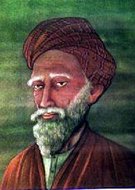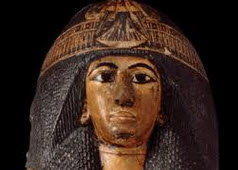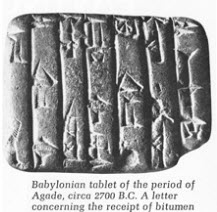Ancient Oil & Gas

- The first evidence for oil product usage was from a very long time ago – natural bitumen has been found on stone tools from Neanderthal sites in Syria dating from ~40,000 years ago.
- By ~3000BC the Indus community of Mehrgarh used naturally occurring bitumen to waterproof crop baskets.
- Herodotus, the ancient Greek historian, claimed that asphalt was used in the construction of the towers of Babylon, around 2000BC. Oil pits were mined near Ardericca, not far from Babylon, and asphalt was also recovered from the banks of local rivers. The present day site of Babylon is at Hillah ~85km south of Baghdad, & natural seeps are still present adjacent to the Euphrates today. The oil described was natural leakage from the Jurassic Iraqi petroleum system, which remains a world-class petroleum province to this day.
- Ancient Egyptians used bitumen during the creation of their mummies – the word mummy is derived from the Arabic mūmiyyah (bitumen).
- Ancient Greeks & Romans, including Pliny the Elder, observed “eternal fires” around the Absheron peninsular (in modern Azerbajian), along with others in Persia and Turkmenia. These eternal fires, created by natural seepage & ignition of gas from the ground, were thought to have inspired Zoroastrainism, one of the world’s oldest religions. The “Pillars of Fire” near modern Baku became a center of worship & pilgrimage, & Zoroastrian priests were entitled athravan (keeper of the fire). The modern word Azerbaijan has a root in Aberbadagan (garden of fire).
- One of the earliest firmly recorded uses of asphalt as a road building material was in Babylon around 625 B.C., in the reign of King Naboppolassar. An preserved inscription records the paving of Procession Street in Babylon, which led from the palace to the north wall of the city, ‘with asphalt and burned brick.’
- The earliest oil wells were drilled in China around 347AD, with depths of up to 240m (~800ft). The drilling was very simple, with basic drill-bits attached to bamboo poles. While the oil was considered to have value, at the time it was actually a secondary commodity – it was burned to evaporate brine to produce the most important ancient commodity of all: salt.
- Chinese drilling continued until the 10th century, by which time extensive bamboo pipelines connected oil wells with salt springs. At around this time Shen Kuo of the Song Dynasty described petroleum as rock-oil (石油 (Shíyóu)), and even noted marine fossils far inland, suggesting some of the principles of geology.
- Also during the 10th Century, al-Mas’udi, an Arabic geographer, observed oil seeps in Sicily, Oman, Yemen, Iraq, Iran, Turkmenistan, Tashkent, India, Sumatra, and Azerbajian. He called the Absheron penisular in modern Azerbaijan bilad al-naffata (the land of the naphtha fountain). By this time it is estimated that 10,000-15,000 people lived in and around Baku, almost of all of whom would have been involved in the industry of extraction of oil and its transportation by ship, cart, or camel. Extraction methods in those times were extremely primitive —mainly hand dug wells at natural seep locations taken to a very shallow depth. The source rock for these historical oil seeps is now known to be the Miocene Maykop Formation, and seeps still exist. The Absheron-Chirag-Gunashli (ACG) & Shah Deniz fields offshore Azerbaijan are amongst the world’s largest modern fields, and the source of 95% of Azeri exports & 50% of Azeri GDP today. The ACG field contains 5-6 billion barrels of recoverable reserves.
- The increased economic extraction of oil from the Caspian region was at least partly facilitated by a technological breakthrough – refining. Persian chemists first distilled kerosene for lighting on an artisanal scale around the 9th to 10th centuries. Similar distillation took until the 12th century to become available in western Europe.

- Some two centuries later Yaqut al-Hamawi, in his 12th century book The Book of All Lands noted that Baku was one of wealthiest Muslim cities, with two “oil-fields” bringing in 2000 silver dirhams a day. By the 1730s these same two oil fields were still being extracted and were named the Balakhani-Sabunchi-Romany & Bibi-Eybat fields, after local owners. It was estimated that their combined output was ~3500 tons annually (~ 80 or 90 barrels a day). This is extremely modest production by today’s industrial standards, but more than half of it was surplus to Baku’s own needs, and thus exportable. As a result of their scale, these fields remained active & dominated middle eastern oil production until modern times, with their names still used for many subsurface rock formations in the South Caspian region today.
- In the 16th century, Sir Walter Raleigh noted the huge pitch lake in the southwest peninsular of Trinidad, using the asphalt to caulk his battered ship. Today the “lake” is though to contain around 10,000,000 tons of pitch, sourced from Trinidad’s Late Cretaceous Naparima Hill & Gautier Formation marine shale source intervals.
- Back on the Absheron peninsular, in modern Azerbaijan, a stone bearing an Arabic inscription has been found in a (now exhausted) petroleum pit that states that it had been worked in the year 1597, giving the name of the operator who leased it. This may be the first direct evidence of a petroleum production licence.
Also Read History of Oil Exploration in Kenya
Photos: Sebastiao Salgado, Leica Gallery Prague




